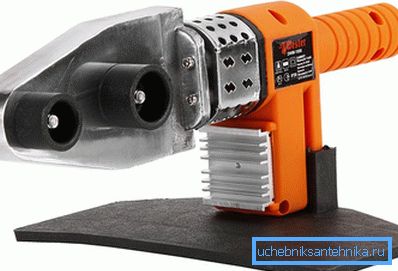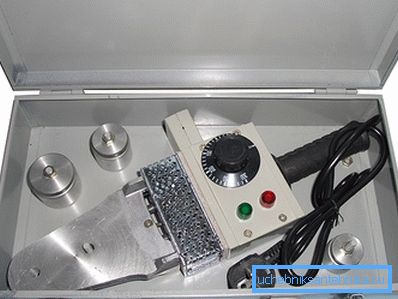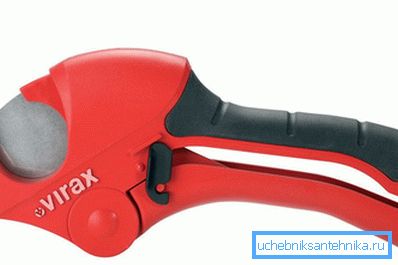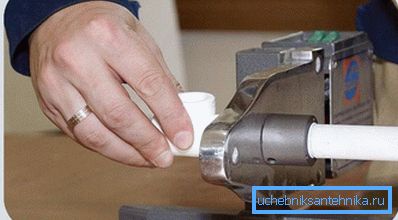Welding polypropylene pipes yourself
During the construction of various facilities there is a need for laying pipelines. Polypropylene is often chosen as the pipe material. Such pipes have a long service life, are relatively inexpensive, they are quickly assembled both in an open and hidden way. However, connecting the pipes requires knowledge and experience, since it requires the use of a special welding tool.
Features of welding of polypropylene pipes
Two pipes are welded using a socket joint: heating the surfaces to be welded without complete melting and loss of shape, and then pressing the heated surfaces. In this case, the inner surface warms up in the coupling, and the outer surface in the pipe. This process is carried out with the help of a welding machine, which is structurally made on one side in the form of a mandrel for fitting a fitting, and on the other hand, sleeves for inserting a pipe. Heating should be carried out to a temperature of about 260 ° C, and for a short time, so that the connecting contact surfaces melt slightly.
Tip! When the temperature maximum is exceeded, polypropylene loses its properties. The maximum permissible deviation should be no more than 10 ° C.
How to choose a welding machine?

Welding machines are designed to use pipes and couplings of certain diameters, subject to this condition, the heating and temperature uniformity is maintained. With increasing diameter should be spent and more power.
Tip! Approximately power in watts should be 10 times the diameter to be welded, measured in mm. Therefore, the use of nozzles is limited to the maximum power of the device.
However, you should not rely on the fact that the technical characteristics of a cheap soldering iron can correspond to reality. This is especially true of Chinese manufacturers. It all depends on the quality of the assembly, which can easily be checked this way: if there are two separate heaters that are switched on separately, this indicates possible unreliability or inconsistency of the declared power, since they can either warm up to the required temperature or turn on each time have a rated power. This can only be verified experimentally during welding.

Each tool has a certain type of thermostat that affects the quality of the weld. The most technological and advanced is the electronic heating controller. It has a special sensor that can monitor the minimum temperature fluctuations near the heated surfaces, take into account the inertia of the heating and adjust the voltage on the heater accordingly. When this is achieved the maximum compliance of temperatures and uniform heating of the connected elements, which allows to obtain a high-strength welded joint. The second type of regulator is capillary type. Its principle of operation is simple: when a certain temperature is reached, the heating is turned off, and when cooled to a certain temperature, it is turned on again. The variation in temperature is up to 100 ° C.

The third type of sensor is a bimetal relay. It is located not so close to the heated surface due to its size, therefore it has a significant inertia that does not allow high-quality welding, since either insufficient heating or melting is possible. For novice welders such a soldering iron is not recommended.
Tip! If you plan to use the welding machine once, then it is better to refuse to buy cheap and low-quality tools, and to rent a professional tool with which you will not have any problems when using, and the welds will be strong and tight.
The welding machine can be manual or stationary. Hand tools will allow you to weld on site almost without any restrictions, as it allows you to work even in the most hard-to-reach places. However, only an experienced welder will be able to precisely center the joints and ensure a tight fit.
Stationary, on the contrary, has more weight and dimensions, but it will allow to carry out high-quality alignment, to provide preliminary preparation of surfaces before connection, and after heating to fix reliably welded pipes until full setting and cooling. In terms of cost, they are quite expensive and therefore are in demand only among professionals.
Preparation of pipes for welding

Before boiling polypropylene pipes, they must be cut to size with a hacksaw, scissors with a special design or pipe cutter. Cutting must be done at right angles so that when joining no empty spaces appear and there is no pressure drop in the pipe. After it is necessary to clean the pipe from sawdust and remove the chamfer from the outside. It is removed at an angle of 30-45 °. You can perform this procedure using a phaser. Pipes with small diameters do not require chamfering.
Welding process
Before starting work, turn on the welding machine and warm it up to operating temperature. After heating, the prepared pipes and fittings are worn on the appropriate heaters. Since the pipe has a diameter greater than the nominal and the fitting is smaller, it is impossible to connect them without heating.

To control the depth of entry on the surface are marks or notches.
Tip! Tensioning of parts on the heating element should be carried out strictly in the coaxial direction, in order to prevent a skew, which may cause damage to the wall and deterioration of the quality of the connection.
Welding nozzles have a conical surface to simplify the procedure of tensioning and heating. When advancing polypropylene parts, the outer part of the pipe rests against the base of the nozzle, melts and takes a rounded shape. At the end of the heating, the fitting and pipe are quickly removed and put on each other with little effort until tight shrinkage. At the same time it is forbidden to scroll through the parts, as in this case it will not be possible to cook well, as this will adversely affect the seam being created. Then the parts are kept in this position for several minutes until the compound cools and becomes homogeneous.
Typical mistakes
The most common mistake is incomplete entry of the pipe into the fitting, which entails the formation of a twist - a weak point in the communications, and, accordingly, a pressure drop during fluid movement.
Another mistake is the use of excessive force when connecting the pipe and coupling, as a result of which, due to the melted ends, a protrusion is created inside, which prevents movement of the working substance.
Welding polypropylene pipes with your own hands requires carefulness and precision of all actions, since it is necessary to achieve optimum heating and then quickly connect the parts. Any delay leads either to material damage or to a poor-quality compound.
Video
To make it easier for you to understand this issue, we invite you to watch this video: